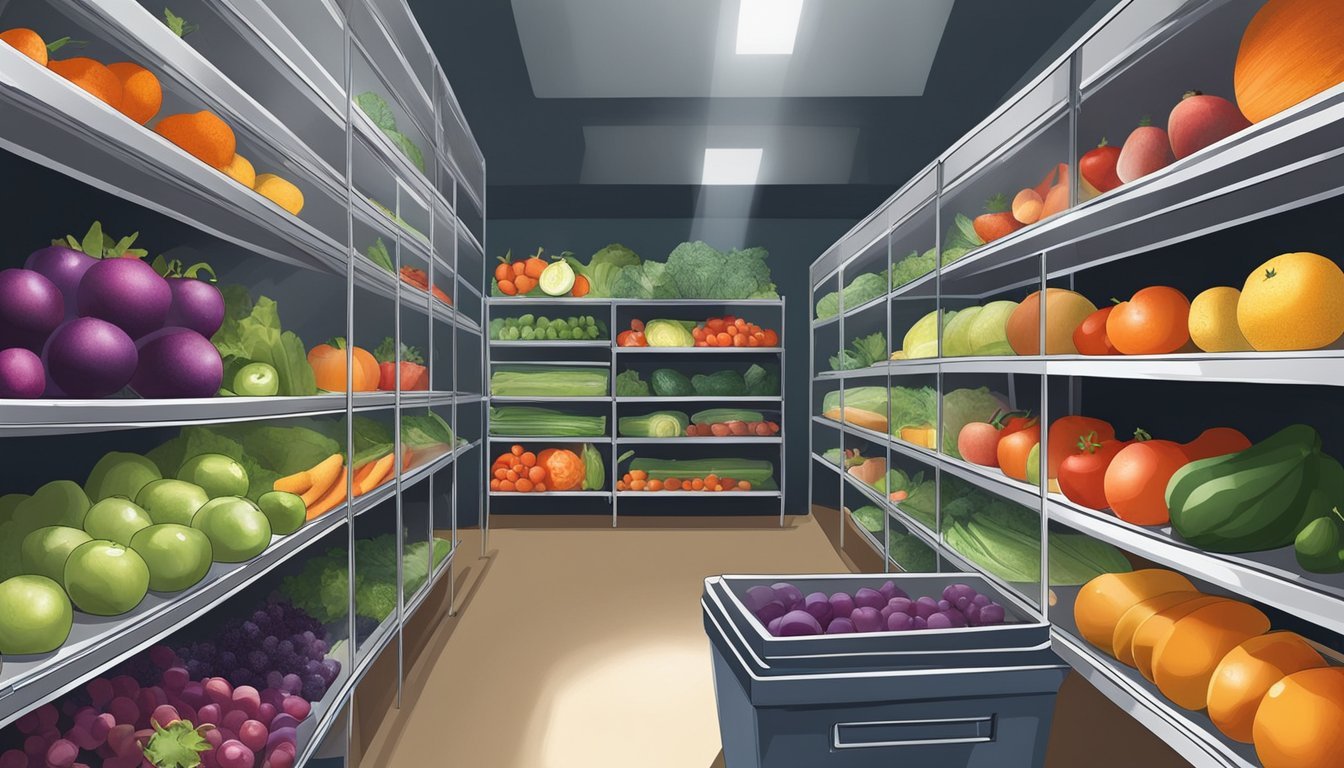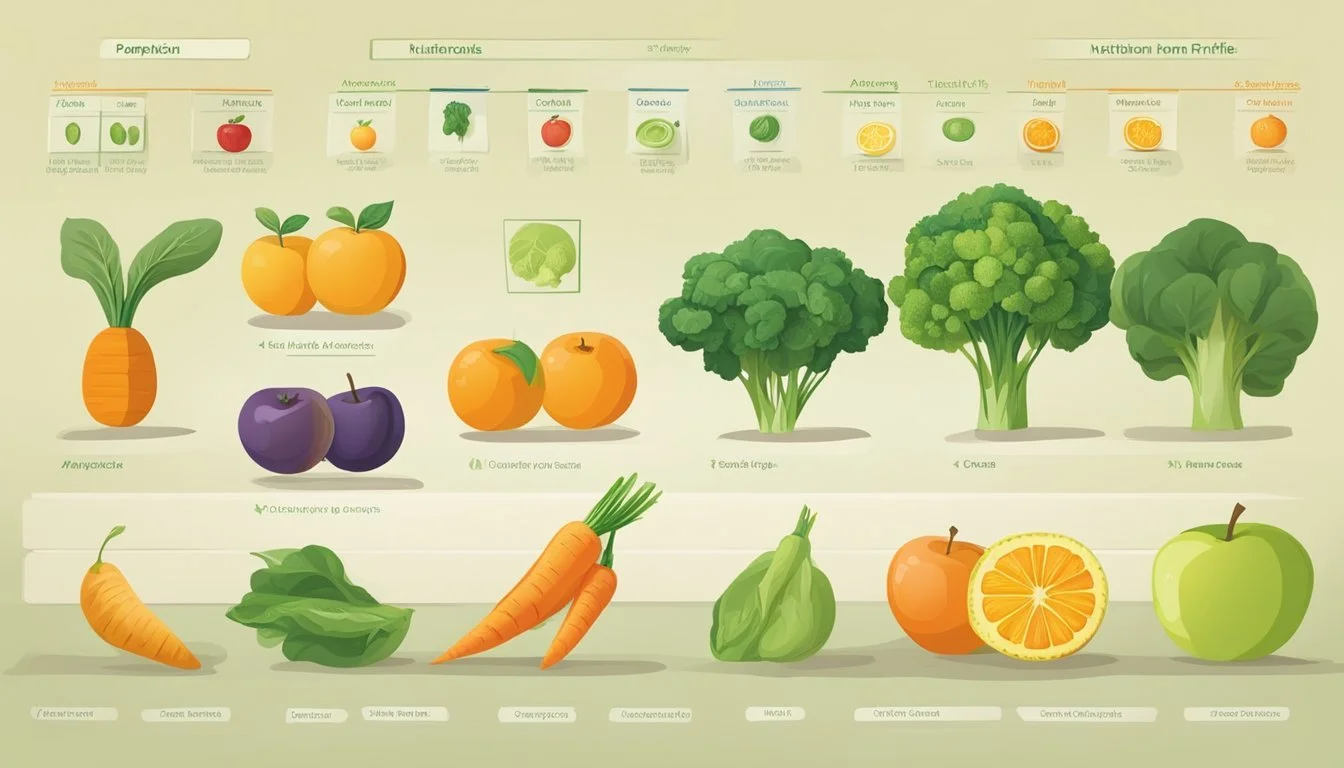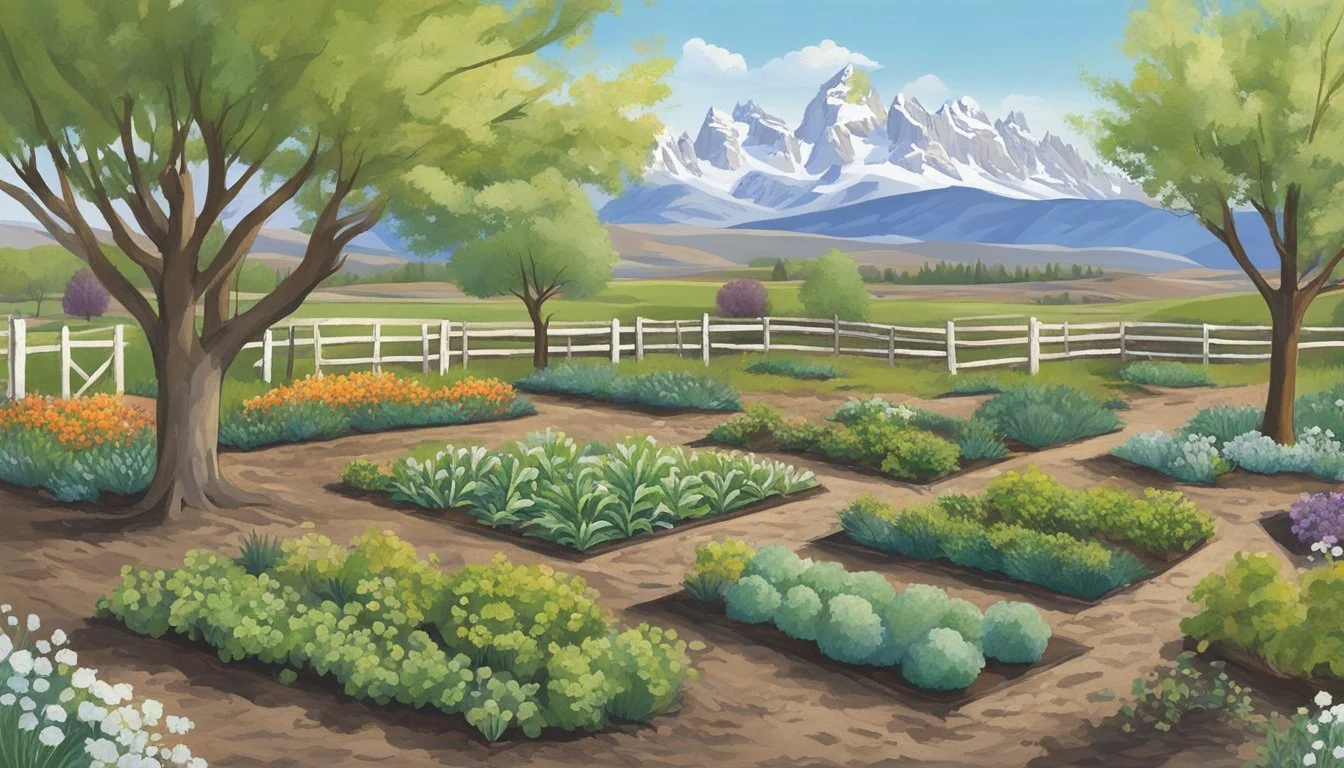Wyoming Seasonal Fruit & Vegetables in March
Your Guide to Fresh Produce
This Article is Part of our Wyoming Seasonal Fruit & Veg Calendar
In Wyoming, the approach of spring in March signals a time of transition for local agriculture. While the climate is known for its volatility, with frequent changes in temperature and weather conditions, there are still opportunities to enjoy seasonal produce. The state's agricultural calendar marks March as a period where winter staples begin to make way for the early whispers of spring harvests.
This month, one might find that the selection of fresh, local fruits and vegetables is not as varied as in the bountiful summer months. However, there are still quality options available for those looking to integrate seasonal offerings into their diet. Hardy vegetables that withstand cooler temperatures, such as broccoli (how long does broccoli last?), often feature prominently, while storage crops like root vegetables continue to be available from winter reserves.
Seasonality plays a crucial role in the availability of produce, and in Wyoming, consumers have the option to support their local farmers by sourcing what is currently in harvest. March doesn't provide the same abundance as other months might, but it does offer its own unique selection, giving a taste of the season's end as well as hints of the new growth just beginning to sprout.
Understanding Seasonal Eating
Seasonal eating involves selecting and consuming produce that is at the peak of its supply during specific times of the year. This practice ensures that individuals enjoy produce when it's fresh, more flavorful, and often more nutrient-dense.
Benefits of Seasonal Eating
Freshness and Flavor: Seasonal fruits and vegetables are typically harvested at the peak of their freshness, which translates to better taste and texture. For instance, as spring approaches in states like Wyoming, produce such as asparagus (What wine goes well with asparagus?) and radishes become more available and offer a crisp, fresh flavor that's hard to match during off-season months.
Nutrient Density: Produce that is consumed close to the time of harvest typically retains more nutrients. Seasonal fruits and vegetables may have a higher vitamin and mineral content compared to those that are harvested early and then shipped long distances.
Challenges in Cold Weather States
Availability of Produce: In states with harsher winters like Wyoming, growing seasons are shorter, and the variety of local seasonal produce available in March can be limited. Cultivating a diverse array of fresh produce during the colder months often requires the use of greenhouses or importing from other states.
Adapting to Seasonal Shifts: As the United States transitions from winter to spring, the produce available may change rapidly. Consumers and local markets in Wyoming must stay informed and flexible to adapt their procurement and eating habits to include the freshest seasonal produce as it comes into season.
Wyoming's March Climate and Agriculture
In March, Wyoming's agriculture is significantly influenced by the transition from the harsh winter conditions to the onset of spring. The climate's impact on the growing season is paramount as producers prepare for planting.
Impact of March Weather
March in Wyoming often brings a mix of wintry and early spring weather. Agriculture must contend with cold temperatures and the potential for late-season snowfall. Average March temperatures can range widely, and sudden temperature fluctuations are common, which can pose challenges for farmers protecting tender plants and preparing the soil.
Precipitation during this period can contribute valuable moisture for the upcoming growing season, yet heavy snow can delay fieldwork and planting. Farmers must remain adaptable and responsive to weather conditions to protect their crops and take advantage of milder days when they occur.
Wyoming's Growing Season
Wyoming's growing season is relatively short due to its northern latitude and high elevation. The average frost-free period varies across the state but is generally limited and ranges from mid-May to September. Even in March, conditions are not typically conducive to outdoor planting of most crops.
However, preparations for the growing season are underway, with the planning of crops, equipment maintenance, and setup of infrastructure like greenhouses. Some cold-hardy plants, such as currants and gooseberries, may be considered for early planting, as they can withstand Wyoming's variable spring weather. Producers often use March to incorporate organic matter into the soil, enhancing fertility for when the outdoor planting season begins.
Farmers rely on their deep understanding of Wyoming's unique climate to make the most of the agricultural opportunities in March.
Fruits Available in Wyoming in March
In March, Wyoming offers a variety of fruits that are available for consumption. The selection of fruits includes citrus varieties and late winter fruits that have been stored to last through the colder months.
Citrus Fruits
March marks the availability of citrus fruits in Wyoming. These fruits typically include:
Oranges: Rich in Vitamin C, oranges are a juicy option for adding a fresh, tangy flavor to the late winter diet.
Grapefruits: Another citrus fruit available is the grapefruit, known for its slightly bitter taste and health benefits.
Late Winter Fruits
Storage and cold season crops provide the following late winter fruits in Wyoming:
Apples: Different apple varieties remain available, coming from late-harvest storage.
Pears: Specifically, varieties such as the Green Anjou pear can be found, offering a subtle sweetness perfect for a range of dishes or as a snack.
Vegetables to Enjoy in March
March heralds the transition from winter to spring, offering a variety of vegetables that thrive in the cooler temperatures of Wyoming. Consumers can take advantage of produce that is both flavorful and nutrient-rich during this month.
Leafy Greens
Spinach (What wine goes well with spinach?) and kale are excellent leafy greens to enjoy in March. These greens are not only versatile for cooking but also rich in vitamins A, C, and K, along with iron and calcium. Spinach offers tender leaves ideal for salads and sautés, while kale provides a heartier texture and robust flavor, suitable for soups and chips.
Spinach: Raw in salads, steamed, or sautéed
Kale: Chips, stews, or as a steamed side dish
Root Vegetables
Root vegetables are at their prime during the cooler months. Beets (how long do beets last?), with their earthy sweetness, are perfect for roasting or can be shredded raw into salads. Carrots, another root vegetable, are known for their versatility and can be enjoyed raw, roasted, or in hearty stews.
Beets: Best when roasted or pickled
Carrots: Enjoy raw as a snack, roasted, or in soups
Cruciferous Vegetables
Cruciferous vegetables like broccoli and cauliflower (how long does cauliflower last?) are excellent choices for March with their dense nutrient profiles and versatility. Broccoli can be enjoyed steamed, roasted, or stir-fried, while cauliflower's mild flavor makes it a great substitute for starches or featured in curries.
Broccoli: Stir-fries, steamed, or roasted with a touch of olive oil
Cauliflower: Rice, roasted, or in a creamy soup
March-Ready Recipes
As March welcomes the early spring produce in Wyoming, chefs and home cooks alike can relish the vibrant colors and fresh flavors. With an emphasis on heartiness and simplicity, these recipes feature the likes of root vegetables and early greens, lending themselves well to salads, casseroles (What wine goes well with casseroles?), and quick steamed or sautéed dishes. (What Wine Pairs Best with Sautéed Dishes)
Hearty Salads and Dressings
With March vegetables like spinach and sweet potatoes, salads become robust meals. A spinach salad with roasted sweet potatoes, drizzled with a homemade olive oil-based dressing, is both nourishing and satisfying. One could also whisk together a creamy dressing using local dairy to complement the fresh, crisp textures.
Ingredients for a Simple Spinach & Sweet Potato Salad:
Spinach: Fresh bunch
Sweet Potatoes: 2, cubed and roasted
Olive Oil: For dressing and roasting
Optional: Nuts or seeds for crunch
Comforting Casseroles
Casseroles are the epitome of comfort food, and utilizing March's seasonal produce can turn them into celebrations of spring. A sweet potato casserole with a pecan topping or a creamy asparagus pasta bake are perfect examples of how simple ingredients can be transformed into heartwarming dishes.
Sample Casserole Dish: Creamy Asparagus and Pasta Bake
Asparagus: 1 lb, trimmed
Pasta: 8 oz, any short variety
Cheese: Preferably a creamy variety, for sauce and topping
Breadcrumbs: For a crispy finish
Simple Steam and Sauté Methods
Quick steam and sauté methods bring out the natural flavors of vegetables without much fuss. For example, steamed broccoli or Brussels sprouts (how long do brussels sprouts last?) can be elevated with just a touch of olive oil and seasoning. Sautéing mushrooms with a bit of garlic and finishing with a pesto swirl can create a simple yet flavorful side.
Steamed Brussels Sprouts with Olive Oil Drizzle:
Brussels Sprouts: 1 lb, cleaned and halved
Olive Oil: A drizzle
Seasoning: Salt and pepper to taste
By making the most of March's produce with these simple cooking methods and recipes, one can truly appreciate the seasonal bounty available in Wyoming.
Food Preservation and Storage Tips
With the diverse climate and elevation ranges in Wyoming, food preservation and storage methods are crucial to extend the shelf life of fresh fruits and vegetables during March, a month when these items are scarce. These techniques ensure a year-round supply and maintain food quality.
Extending Freshness
Fresh fruits and vegetables contain enzymes that cause ripening and eventual spoilage. Refrigeration can significantly slow this process, but optimal temperatures vary based on produce type.
For most fruits, like apples and pears, they should be stored in a cool, dark place and individually wrapped to prevent the spread of decay.
For most vegetables, like leafy greens, they should be kept in high-humidity compartments in the fridge, often in perforated plastic bags to allow for some air circulation.
Home Canning Strategies
Home canning is a powerful method for preserving the bounty of Wyoming's short grow season. Due to the state's high altitudes, adjustments to processing time or pressure are necessary to ensure safe preservation.
To maintain food safety:
High-acid foods (like fruits and fruit spreads) should be processed in a boiling water canner.
Low-acid foods (like vegetables and meats) require a pressure canner to prevent the risk of botulism.
Before each canning season, it is imperative to check a pressure canner's gauge for accuracy.
Proper Vegetable Storage
Effective vegetable storage varies depending on the specific type of vegetable. For optimal results, consider the following suggestions:
Root vegetables (carrots, beets):
Store in a cool, dark, and well-ventilated place, such as a root cellar.
Sand or peat can be used to keep them moist.
Cruciferous vegetables (broccoli, cabbage):
Preferably store in the refrigerator's crisper drawer.
Avoid washing before storage to minimize moisture, which can lead to mold growth.
Alliums (onions, garlic):
Require a dry, dark area with good air circulation.
Avoid storing near potatoes, as the gases they emit can hasten spoilage.
By implementing correct food preservation and storage techniques, Wyoming residents can enjoy local produce throughout the leaner months.
Wyoming's Local Markets and Supply Chains
March in Wyoming brings a focus on the resilience and accessibility of local food supply chains. The state's commitment to local markets and CSA programs plays a significant role in ensuring that seasonal fruits and vegetables reach consumers.
Farmers Markets
Farmers markets in Wyoming act as critical hubs for local produce during the growing season. Though March is outside the typical growing season, some markets adapt to provide storage crops and greenhouse-grown produce. They provide a direct channel for consumers to purchase high-quality, local products, often including items like winter squash and root vegetables.
Community Supported Agriculture (CSA)
CSA programs in Wyoming offer a platform for consumers to buy seasonal produce directly from farmers through a subscription-based service. Members receive a share of freshly harvested produce on a regular schedule, typically featuring storage crops and winter-hardy produce during early spring. This direct-to-consumer model strengthens the local supply chain and supports Wyoming's agricultural economy.
Nutritional Profiles of March Produce
March offers a variety of fresh produce, each with its distinct nutritional benefits. Broccoli and asparagus, two common vegetables available in Wyoming during this month, are excellent sources of vitamins and minerals.
Broccoli is rich in vitamin C, essential for the immune system, and is also high in fiber, which supports digestive health. It contains a variety of nutrients, including potassium, folate, and vitamins A, K.
Nutrient Benefit Vitamin C Immune system support, skin health Fiber Digestive health, satiety Vitamin K Bone health, blood clotting Folate Cell growth, maternal health during pregnancy
Asparagus, another spring vegetable, is known for its slender stalks and is high in fiber and vitamins A, C, E, and K. It provides an ample amount of folate and is also a good source of minerals like iron and copper.
Nutrient Benefit Fiber Digestive health, blood sugar regulation Vitamin A Vision, immune function, skin health Vitamin C Antioxidant properties, iron absorption Vitamin E Antioxidant properties, cell protection Vitamin K Blood health, bone metabolism
Strawberries begin to appear by the end of March. Although slightly more tart at this time, they boast high vitamin C content and are a sweet treat that can be included in a balanced diet. They are low in calories yet surprisingly high in fiber, beneficial for those monitoring their sugar intake.
Gardening Tips for Wyoming's Early Spring
Selecting Appropriate Varieties: Gardeners in Wyoming should focus on cold-hardy crops for early spring planting. Choices include leafy greens like kale and spinach, root vegetables such as beets and carrots, and various types of lettuce, including Butterhead and Boston. These varieties are well-suited to the cooler temperatures and potential frost conditions of Wyoming's early spring.
Soil Preparation: As the ground thaws, it's crucial for Wyoming gardeners to prepare the soil for planting. They should ensure proper drainage and incorporate organic material, such as compost, to provide a rich foundation for young plants.
Gardening Activity Description Starting Seeds Indoors Begin with indoor propagation of seeds to safeguard against late spring frosts. Soil Amendment Work compost into the soil to improve fertility. Frost Protection Have cloths or frost blankets ready to protect new seedlings.
Timing of Planting: Gardeners should monitor soil temperature, as certain crops thrive when planted in soil that is consistently above 40 degrees Fahrenheit. Planting too early may expose seedlings to harsh conditions, while late planting can shortchange the growing season.
Herb Considerations: Early spring is also a suitable time to establish hardy herbs in Wyoming gardens. Varieties like parsley, chives (how long do chives last?), and cilantro can withstand cooler temperatures, making them excellent candidates for early sowing.
Watering Practices: Although Wyoming springs can be wet, gardeners must still ensure consistent soil moisture, especially during seed germination and early growth stages. However, they should avoid overwatering, which can lead to root rot in cool, damp soils.
Pest Management: Gardeners should remain vigilant for signs of pests, using methods such as row covers to protect young plants without resorting to chemical treatments unless necessary.










